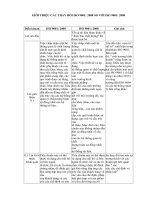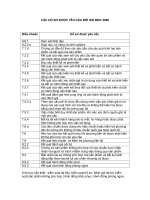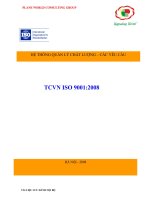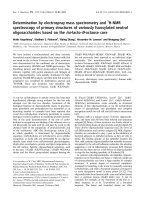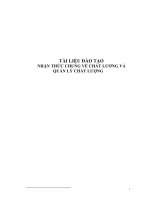ISO 287061:2008 Vitreous and porcelain enamels — Determination of resistance to chemical corrosion — Part 1: Determination of resistance to chemical corrosion by acids at room temperature
Bạn đang xem bản rút gọn của tài liệu. Xem và tải ngay bản đầy đủ của tài liệu tại đây (227.03 KB, 14 trang )
INTERNATIONAL ISO
STANDARD 28706-1
First edition
2008-12-01
Vitreous and porcelain enamels —
Determination of resistance to chemical
corrosion —
Part 1:
Determination of resistance to chemical
corrosion by acids at room temperature
Émaux vitrifiés — Détermination de la résistance à la corrosion
chimique —
Partie 1: Détermination de la résistance à la corrosion chimique par les
acides à température ambiante
Reference number
ISO 28706-1:2008(E)
© ISO 2008
ISO 28706-1:2008(E)
PDF disclaimer
This PDF file may contain embedded typefaces. In accordance with Adobe's licensing policy, this file may be printed or viewed but
shall not be edited unless the typefaces which are embedded are licensed to and installed on the computer performing the editing. In
downloading this file, parties accept therein the responsibility of not infringing Adobe's licensing policy. The ISO Central Secretariat
accepts no liability in this area.
Adobe is a trademark of Adobe Systems Incorporated.
Details of the software products used to create this PDF file can be found in the General Info relative to the file; the PDF-creation
parameters were optimized for printing. Every care has been taken to ensure that the file is suitable for use by ISO member bodies. In
the unlikely event that a problem relating to it is found, please inform the Central Secretariat at the address given below.
COPYRIGHT PROTECTED DOCUMENT
© ISO 2008
All rights reserved. Unless otherwise specified, no part of this publication may be reproduced or utilized in any form or by any means,
electronic or mechanical, including photocopying and microfilm, without permission in writing from either ISO at the address below or
ISO's member body in the country of the requester.
ISO copyright office
Case postale 56 • CH-1211 Geneva 20
Tel. + 41 22 749 01 11
Fax + 41 22 749 09 47
Web www.iso.org
Published in Switzerland
ii © ISO 2008 – All rights reserved
ISO 28706-1:2008(E)
Contents Page
Foreword............................................................................................................................................................ iv
Introduction ........................................................................................................................................................ v
1 Scope ..................................................................................................................................................... 1
2 Normative references ........................................................................................................................... 1
3 Principle ................................................................................................................................................. 1
4 Reagents ................................................................................................................................................ 1
5 Materials and apparatus....................................................................................................................... 2
6 Test specimens ..................................................................................................................................... 2
7 Procedure .............................................................................................................................................. 2
7.1 Attack by the test solution ................................................................................................................... 2
7.2 Determination........................................................................................................................................ 3
8 Classification of results ....................................................................................................................... 3
9 Citric acid test at room temperature ................................................................................................... 4
9.1 Test solution.......................................................................................................................................... 4
9.2 Test time ................................................................................................................................................ 4
9.3 Test report ............................................................................................................................................. 4
10 Sulfuric acid test at room temperature............................................................................................... 5
10.1 Test solution.......................................................................................................................................... 5
10.2 Test time ................................................................................................................................................ 5
10.3 Test report ............................................................................................................................................. 5
11 Other test solutions at room temperature.......................................................................................... 5
11.1 Test solution.......................................................................................................................................... 5
11.2 Test time ................................................................................................................................................ 5
11.3 Test report ............................................................................................................................................. 5
© ISO 2008 – All rights reserved iii
ISO 28706-1:2008(E)
Foreword
ISO (the International Organization for Standardization) is a worldwide federation of national standards bodies
(ISO member bodies). The work of preparing International Standards is normally carried out through ISO
technical committees. Each member body interested in a subject for which a technical committee has been
established has the right to be represented on that committee. International organizations, governmental and
non-governmental, in liaison with ISO, also take part in the work. ISO collaborates closely with the
International Electrotechnical Commission (IEC) on all matters of electrotechnical standardization.
International Standards are drafted in accordance with the rules given in the ISO/IEC Directives, Part 2.
The main task of technical committees is to prepare International Standards. Draft International Standards
adopted by the technical committees are circulated to the member bodies for voting. Publication as an
International Standard requires approval by at least 75 % of the member bodies casting a vote.
Attention is drawn to the possibility that some of the elements of this document may be the subject of patent
rights. ISO shall not be held responsible for identifying any or all such patent rights.
ISO 28706-1 was prepared by the European Committee for Standardization (CEN) (as EN 14483-1) and was
adopted, under a special “fast-track procedure”, by Technical Committee ISO/TC 107, Metallic and other
inorganic coatings, in parallel with its approval by the ISO member bodies.
It cancels and replaces ISO 2722:1997 and ISO 8290:1998, which have been technically revised.
ISO 28706 consists of the following parts, under the general title Vitreous and porcelain enamels —
Determination of resistance to chemical corrosion:
⎯ Part 1: Determination of resistance to chemical corrosion by acids at room temperature
⎯ Part 2: Determination of resistance to chemical corrosion by boiling acids, boiling neutral liquids and/or
their vapours
⎯ Part 3: Determination of resistance to chemical corrosion by alkaline liquids using a hexagonal vessel
⎯ Part 4: Determination of resistance to chemical corrosion by alkaline liquids using a cylindrical vessel
⎯ Part 5: Determination of resistance to chemical corrosion in closed systems
iv © ISO 2008 – All rights reserved
ISO 28706-1:2008(E)
Introduction
Corrosion of vitreous and porcelain enamels by aqueous solutions is a dissolution process. The main
component of the enamel, SiO2, forms a three-dimensional silica network. After hydrolysis, it decomposes and
forms silicic acid or silicates. These are released into the attacking medium. Other components, mainly metal
oxides, are hydrolysed as well and form the corresponding hydrated metal ions or hydroxides. All corrosion
products are more or less soluble in the attacking medium. The whole process results in a loss in mass per
unit area.
For some aqueous solutions, the attack on the enamel proceeds linearly during the corrosion time; for other
aqueous solutions, the attack on the enamel proceeds in a logarithmic manner during the corrosion time. Only
for the first series of solutions can a scientifically exact rate of loss in mass per unit area (g/m2⋅h) be
calculated as well as a corrosion rate (mm/year).
The most important parameters influencing aqueous corrosion of the enamel are the enamel quality, the
temperature and the pH-value. Inhibition effects resulting from the limited solubility of silica can also contribute.
The following list describes different types of enamel attack for different corrosion conditions:
a) In aqueous alkali solutions like 0,1 mol/l NaOH (see Clause 9 of ISO 28706-4:2008), the silica network of
the enamel is considerably attacked at 80 °C. Silicates and most of the other hydrolysed components are
soluble in the alkali. Attack proceeds linearly during regular test times. Therefore, test results are
expressed in terms of a rate of loss in mass per unit area (mass loss per unit area and time) and a
corrosion rate (millimetres per year).
b) At room temperature, in weak aqueous acids like citric acid (see Clause 9 of ISO 28706-1:2008) or also in
stronger acids like sulfuric acid (see Clause 10 of ISO 28706-1:2008), there is only minor attack on the
silica network of the enamel. Other constituents are leached to some extent from the surface. Highly
resistant enamels will show no visual change after exposure. On less resistant enamels, some staining or
surface roughening will occur.
c) In boiling aqueous acids (see ISO 28706-2), the silica network of the enamel is being attacked, and silica
as well as the other enamel components are released into solution. However, the solubility of silica in
acids is low. Soon, the attacking solutions will become saturated with dissolved silica and will then only
leach the surface. The acid attack is inhibited and the rate of corrosion drops markedly.
NOTE The glass test equipment also releases silica by acid attack and contributes to the inhibition of the
corrosion.
Inhibition is effectively prevented in vapour phase tests. The condensate formed on the test specimen is
free of any dissolved enamel constituents.
Examples of enamel corrosion proceeding in a logarithmic manner [see 1)] and linearly [see 2)] are:
1) Boiling citric acid (see Clause 10 of ISO 28706-2:2008) and boiling 30 % sulfuric acid (see
Clause 11 of ISO 28706-2:2008)
Since only minute amounts of these acids are found in their vapours, the test is restricted to the liquid
phase. The attack is influenced by inhibition effects, and corrosion depends on the time of exposure.
Therefore, test results are expressed in terms of loss in mass per unit area; no rate of loss in mass
per unit area is calculated.
2) Boiling 20 % hydrochloric acid (see Clause 12 of ISO 28706-2:2008)
Since this is an azeotropic boiling acid, its concentration in the liquid and the vapour phase are
identical, and liquid phase testing need not be performed. Vigorous boiling supplies an uninhibited
condensate, and the attack proceeds linearly with time of exposure. Therefore, test results are only
© ISO 2008 – All rights reserved v
ISO 28706-1:2008(E)
expressed in terms of rate of loss in mass per unit area (mass loss per unit area and time) and the
corrosion rate (millimetres per year).
d) At high temperatures, with tests in the liquid phase under autoclave conditions (see ISO 28706-5),
aqueous acid attack is severe. To avoid inhibition, the test time is restricted to 24 h and the ratio of
attacking acid to attacked enamel surface is chosen so that it is comparatively high (similar to that in a
chemical reaction vessel). In addition, only low-silica water is used for the preparation of test solutions.
Under these conditions, attack will proceed linearly with time of exposure. Therefore, test results with
20 % hydrochloric acid (see Clause 8 of ISO 28706-5:2008), artificial test solutions (see Clause 10 of
ISO 28706-5:2008) or process fluids (see Clause 11 of ISO 28706-5:2008) are also expressed in terms of
a rate of loss in mass per unit area (loss in mass per unit area and time).
e) In boiling water (see Clause 13 of ISO 28706-2:2008), the silica network is fairly stable. The enamel
surface is leached and silica is dissolved only to a small extent. This type of attack is clearly represented
by the vapour phase attack. In the liquid phase, some inhibition can be observed with highly resistant
enamels. However, if the enamel being tested is weak, leached alkali from the enamel can raise
pH-values to alkaline levels, thus increasing the attack by the liquid phase. Both liquid and vapour phase
testing can give valuable information.
f) Since the attack may or may not be linear, the results are expressed only in terms of loss in mass per unit
area, and the test time should be indicated.
g) For standard detergent solution (see Clause 9 of ISO 28706-3:2008), it will not be certain whether the
linear part of the corrosion curve will be reached during testing for 24 h or 168 h. Calculation of the
corrosion rate is therefore not included in the test report.
h) For other acids (see Clause 14 of ISO 28706-2:2008) and other alkaline solutions (see Clause 10 of
ISO 28706-3:2008 and Clause 10 of ISO 28706-4:2008), it will also not be known if a linear corrosion rate
will be reached during the test period. Calculation of the corrosion rate is therefore not included in the test
reports of those parts of this International Standard.
For vitreous enamels fired at temperatures below 700 °C, the test parameters (media, temperatures and
times) of this International Standard are not appropriate. For such enamels, for example aluminium enamels,
other media, temperatures and/or times should be used. This can be done following the procedures described
in the clauses for “Other test solutions” in Parts 1, 2, 3 and 4 of this International Standard.
vi © ISO 2008 – All rights reserved
INTERNATIONAL STANDARD ISO 28706-1:2008(E)
Vitreous and porcelain enamels — Determination of resistance
to chemical corrosion —
Part 1:
Determination of resistance to chemical corrosion by acids at
room temperature
1 Scope
This part of ISO 28706 describes a test method for the determination of the resistance of vitreous and
porcelain enamelled articles to attack by an acid at room temperature, and also specifies a method of
classifying the results.
2 Normative references
The following referenced documents are indispensable for the application of this document. For dated
references, only the edition cited applies. For undated references, the latest edition of the referenced
document (including any amendments) applies.
ISO 1042, Laboratory glassware — One-mark volumetric flasks
ISO 3696, Water for analytical laboratory use — Specification and test methods
ISO 4788, Laboratory glassware — Graduated measuring cylinders
ISO 28764, Vitreous and porcelain enamels — Production of specimens for testing enamels on sheet steel,
sheet aluminium and cast iron
3 Principle
Part of the surface of a test specimen is exposed under defined conditions to attack by an acid solution.
Resistance is assessed by methods based on the appearance and cleanability of the enamelled surface.
4 Reagents
During the determination, use only reagents of recognized analytical grade, unless otherwise specified.
4.1 Water, conforming to the requirements of grade 3 of ISO 3696, i.e. distilled water or water of equivalent
purity.
4.2 Degreasing solvent, such as ethanol, or water (4.1) containing a few drops of liquid detergent, suitable
for cleaning the test apparatus and test specimens.
4.3 Titanium dioxide, pigment grade.
© ISO 2008 – All rights reserved 1
ISO 28706-1:2008(E)
4.4 Citric acid monohydrate, (C6H8O7·H2O), crystalline.
4.5 Sulfuric acid, (H2SO4), analytical grade, c(H2SO4) = 0,5 mol/l.
5 Materials and apparatus
5.1 Graduated measuring cylinder, capacity 100 ml, conforming to the requirements of ISO 4788.
5.2 One-mark volumetric flask, capacity 100 ml, conforming to the requirements of ISO 1042.
5.3 Pipette, of a suitable size (see 7.1).
5.4 Towel, of white cotton or linen.
5.5 Filter paper, free from fluoride, thickness less than 0,18 mm, approximately 30 mm in diameter (only to
be used for testing of curved surfaces).
5.6 Filter paper, free from fluoride, thickness greater than 0,38 mm, approximately 25 mm in diameter (only
to be used for testing of curved surfaces).
5.7 Filter paper, free from fluoride.
5.8 Pencil, HB hardness or equivalent.
5.9 Caps (e.g. curved glasses), made of polyethylene or other suitable flexible material, or glass, having an
external diameter approximately 30 mm.
6 Test specimens
The test specimens shall be commercial items, parts thereof, or test pieces especially prepared in accordance
with the appropriate standard for that base material.
The production of test specimens for testing vitreous and porcelain enamels for steel sheet, cast iron and
aluminium is specified in ISO 28764.
Each test specimen shall be cleaned with the degreasing solvent (4.2), then rinsed with hot water until the
water spreads evenly on the surface, and then finally dried by dabbing (not rubbing) with a clean towel (5.4).
7 Procedure
7.1 Attack by the test solution
Using the pipette (5.3), place a few drops of the attacking medium (see 9.1, 10.1 and 11.1), on each specimen
and keep it at a temperature of 23 °C ± 3 °C during the whole period of the test, ensuring that there is a
continuous treatment area, the diameter of which shall be less than that of the cap (5.9). Cover the treatment
area immediately with the cap.
In the case of curved surfaces, place a thin filter paper (5.5) on the area to be treated. On top of this put the
thicker filter paper (5.6). Apply a few drops of the attacking medium (see 9.1, 10.1, 11.1) to the top filter paper
(5.6) until both filters are saturated. Cover the filter papers to prevent evaporation, for example with a cap (5.9),
and keep the specimen at a temperature of 23 °C ± 3 °C.
After the predefined test time, remove the cap (5.9) and filter papers (5.5 and 5.6), wash the test specimen
with either water (4.1) or tap water, and then dry it by dabbing (not rubbing) with filter paper (5.7).
2 © ISO 2008 – All rights reserved
ISO 28706-1:2008(E)
When using tap water, ensure that a residual film is not allowed to form, otherwise the classification may be
affected.
7.2 Determination
7.2.1 General
Examine each test specimen within 2 h of completion of the attack by the test solution. For the evaluation,
consider only that part of the surface which has been exposed to the attacking medium as a treatment area.
Base the evaluation on the examinations described in 7.2.2, 7.2.3 and 7.2.4, which are in accordance with the
scheme and classification given in Figure 1 and Table 1.
7.2.2 Visual examination
View, using normal or corrected vision, the different areas at varying angles at a distance of 250 mm from the
test specimen, without the aid of a magnifying glass, in order to ascertain whether the treated area differs from
the non-treated area (e.g. whether the brightness or the colour has changed or whether some spots have
appeared). Carry out the examination either in daylight, avoiding direct sunlight, or in artificial light, provided
the latter is uniform and sufficiently intense. Judge the test specimen to have failed the visual examination if
the treated area differs in any respect from the non-treated area.
7.2.3 Rubbing test (dry)
Draw, using a pencil (5.8), a number of approximately parallel lines across both the treated and the non-
treated areas. For black and dark coloured enamels, rub titanium dioxide (4.3) on to the two areas instead of
using a pencil. Then rub the test specimen with a dry towel (5.4). Judge the test specimen to have failed the
dry rubbing test if the markings on the treated area are more difficult to remove than those on the non-treated
area.
7.2.4 Rubbing test (moist)
Draw, using a pencil (5.8), a number of approximately parallel lines across both the treated and the non-
treated areas. For black and dark coloured enamels, rub titanium dioxide (4.3) on to the two areas instead of
using a pencil. Then rub the test specimen with a towel (5.4) which has been moistened with water (4.1) and
thoroughly wrung out (do not use soap or detergent). Judge the test specimen to have failed the moist rubbing
test if the markings on the treated area are more difficult to remove than those on the non-treated area.
8 Classification of results
Dependent on the results of the determinations which have been performed in accordance with 7.2, classify
the vitreous or porcelain enamel as shown in Table 1.
© ISO 2008 – All rights reserved 3
ISO 28706-1:2008(E)
Figure 1 — Test scheme
Table 1 — Classification
Type of examination Class
Visual examination — passed AA
Rubbing test (dry) — passed A+
Rubbing test (moist) — passed A
Rubbing test (moist) — failed
Unclassified
9 Citric acid test at room temperature
9.1 Test solution
Dissolve 10 g of pure crystalline citric acid monohydrate (C6H8O7·H2O) (4.4) in water (4.1), transfer to a
100 ml volumetric flask (5.2) and dilute to the mark with water (4.1). A fresh solution, prepared the same day,
is required for each test.
9.2 Test time
The test time shall be 15 min ± 30 s.
9.3 Test report
The test report shall include the following information:
a) all information necessary for the identification of the sample tested;
b) a reference to Clause 9 of this part of ISO 28706, e.g. “Tested in accordance with Clause 9 of
ISO 28706-1:2008 — citric acid at room temperature”;
4 © ISO 2008 – All rights reserved
ISO 28706-1:2008(E)
c) the results, including the results of the individual determinations, giving the classification of the vitreous or
porcelain enamel in accordance with Table 1;
d) any deviations from the procedure specified;
e) any unusual features observed during the test;
f) the date of the test.
10 Sulfuric acid test at room temperature
10.1 Test solution
Measure 41 ml of analytical grade sulfuric acid, c(H2SO4) = 0,5 mol/l (4.5), in a graduated measuring cylinder
(5.1), transfer to a 100 ml volumetric flask (5.2) and dilute to the mark with water (4.1).
10.2 Test time
The test time shall be 15 min ± 30 s.
10.3 Test report
The test report shall include the following information:
a) all information necessary for the identification of the sample tested;
b) a reference to Clause 10 of this part of ISO 28706, e.g. “Tested in accordance with Clause 10 of
ISO 28706-1:2008 — sulfuric acid at room temperature”;
c) the results, including the results of the individual determinations, giving the classification of the vitreous or
porcelain enamel in accordance with Table 1;
d) any deviations from the procedure specified;
e) any unusual features observed during the test;
f) the date of the test.
11 Other test solutions at room temperature
11.1 Test solution
An agreed test solution shall be made up using water (4.1) and reagents of analytical grade.
11.2 Test time
The test time shall be given in the test report.
11.3 Test report
The test report shall include the following information:
a) all information necessary for the identification of the sample tested;
b) a reference to Clause 11 of this part of ISO 28706, e.g. “Tested in accordance with Clause 11 of
ISO 28706-1:2008 — other acids at room temperature”;
© ISO 2008 – All rights reserved 5
ISO 28706-1:2008(E)
c) the type of acid used and its concentration;
d) the results, including the results of the individual determinations, giving the classification of the vitreous or
porcelain enamel in accordance with Table 1;
e) the test time;
f) any deviations from the procedure specified;
g) any unusual features observed during the test;
h) the date of the test.
6 © ISO 2008 – All rights reserved
ISO 28706-1:2008(E)
ICS 25.220.50
Price based on 6 pages
© ISO 2008 – All rights reserved



